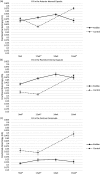Quantitative DTI metrics in a canine model of Krabbe disease: comparisons versus age-matched controls across multiple ages
- PMID: 29350082
- PMCID: PMC5882059
- DOI: 10.1177/1971400917733431
Quantitative DTI metrics in a canine model of Krabbe disease: comparisons versus age-matched controls across multiple ages
Abstract
Purpose The purpose of this study was to compare quantitative diffusion tensor imaging metrics in dogs affected with a model of Krabbe disease to age-matched normal controls. We hypothesized that fractional anisotropy would be decreased and radial diffusivity would be increased in the Krabbe dogs. Methods We used a highly reproducible region-of-interest interrogation technique to measure fractional anisotropy and radial diffusivity in three different white matter regions within the internal capsule and centrum semiovale in four Krabbe affected brains and three age-matched normal control brains. Results Despite all four Krabbe dogs manifesting pelvic limb paralysis at the time of death, age-dependent differences in DTI metrics were observed. In the 9, 12, and 14 week old Krabbe dogs, FA values unexpectedly increased and RD values decreased. FA values were generally higher and RD values generally lower in both regions of the internal capsule in the Krabbe brains during this period. FA values in the brain from the 16 week old Krabbe dog decreased and were lower than in control brains and RD values increased and were higher than in control brain. Conclusion Our findings suggest that FA and RD in the internal capsule and centrum semiovale are affected differently at different ages, despite disease having progressed to pelvic limb paralysis in all dogs evaluated. In 9, 12, and 14 week old Krabbe dogs, higher FA values and lower RD values are seen in the internal capsule. However, in the 16 week old Krabbe dog, lower FA and higher RD values are seen, consistent with previous observations in Krabbe dogs, as well as observations in human Krabbe patients.
Keywords: Diffusion tensor; Krabbe; canine; fractional anisotropy; lysosomal storage disease; magnetic resonance; radial diffusivity.
Figures



Similar articles
-
Diffusion tensor imaging analysis of the brain in the canine model of Krabbe disease.Neuroradiol J. 2016 Dec;29(6):417-424. doi: 10.1177/1971400916665378. Epub 2016 Sep 27. Neuroradiol J. 2016. PMID: 27677296 Free PMC article.
-
Novel diffusion tensor imaging findings in Krabbe disease.Eur J Paediatr Neurol. 2014 Mar;18(2):150-6. doi: 10.1016/j.ejpn.2013.09.008. Epub 2013 Oct 9. Eur J Paediatr Neurol. 2014. PMID: 24149099
-
Diffusion tensor imaging findings suggestive of white matter alterations in a canine model of mucopolysaccharidosis type I.Neuroradiol J. 2018 Feb;31(1):90-94. doi: 10.1177/1971400917715792. Epub 2017 Jul 11. Neuroradiol J. 2018. PMID: 28695759 Free PMC article.
-
The role of diffusion tensor imaging and fractional anisotropy in the evaluation of patients with idiopathic normal pressure hydrocephalus: a literature review.Neurosurg Focus. 2016 Sep;41(3):E12. doi: 10.3171/2016.6.FOCUS16192. Neurosurg Focus. 2016. PMID: 27581308 Review.
-
White matter microstructural damage in early treated phenylketonuric patients.Orphanet J Rare Dis. 2018 Oct 26;13(1):188. doi: 10.1186/s13023-018-0912-5. Orphanet J Rare Dis. 2018. PMID: 30367646 Free PMC article.
Cited by
-
Companion animal models of neurological disease.J Neurosci Methods. 2020 Feb 1;331:108484. doi: 10.1016/j.jneumeth.2019.108484. Epub 2019 Nov 13. J Neurosci Methods. 2020. PMID: 31733285 Free PMC article. Review.
-
Brain diffusion tensor imaging in dogs with degenerative myelopathy.J Vet Intern Med. 2021 Sep;35(5):2342-2349. doi: 10.1111/jvim.16248. Epub 2021 Aug 19. J Vet Intern Med. 2021. PMID: 34410026 Free PMC article.
-
Magnetic Resonance Imaging and Histopathologic Findings From a Standard Poodle With Neonatal Encephalopathy With Seizures.Front Vet Sci. 2020 Nov 10;7:578936. doi: 10.3389/fvets.2020.578936. eCollection 2020. Front Vet Sci. 2020. PMID: 33244473 Free PMC article.
-
Diffusion tensor-based analysis of white matter in dogs with idiopathic epilepsy.Front Vet Sci. 2023 Dec 18;10:1325521. doi: 10.3389/fvets.2023.1325521. eCollection 2023. Front Vet Sci. 2023. PMID: 38192722 Free PMC article.
-
Krabbe disease: New hope for an old disease.Neurosci Lett. 2021 May 1;752:135841. doi: 10.1016/j.neulet.2021.135841. Epub 2021 Mar 22. Neurosci Lett. 2021. PMID: 33766733 Free PMC article. Review.
References
-
- Beaulieu C. The basis of anisotropic water diffusion in the nervous system - a technical review. NMR Biomed 2002; 15: 435–455. - PubMed
-
- Beaulieu C, et al. Changes in water diffusion due to Wallerian degeneration in peripheral nerve. Magn Reson Med 1996; 36: 627–631. - PubMed
-
- Song SK, et al. Dysmyelination revealed through MRI as increased radial (but unchanged axial) diffusion of water. Neuroimage 2002; 17: 1429–1436. - PubMed
Publication types
MeSH terms
Grants and funding
LinkOut - more resources
Full Text Sources
Other Literature Sources
Medical
Miscellaneous

